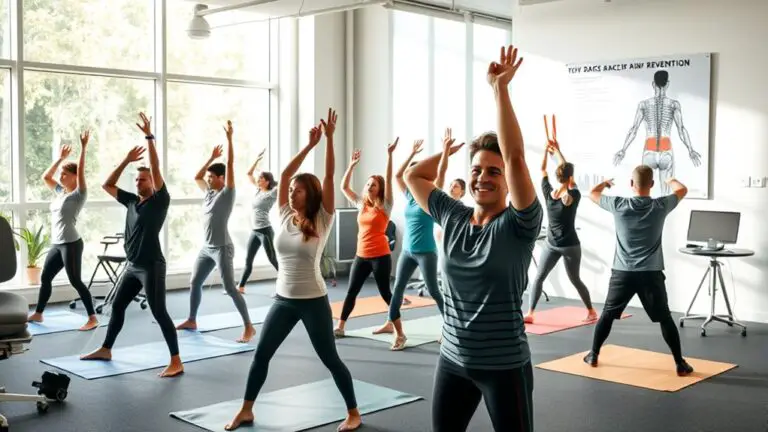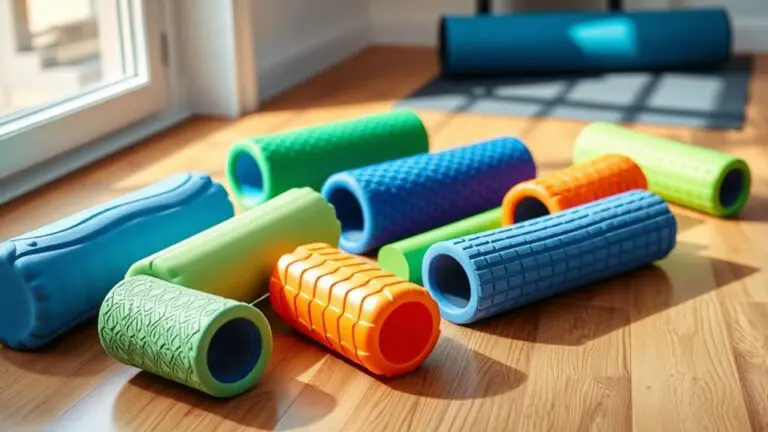The Best Warm-Up Routines to Prevent Injury in the Gym
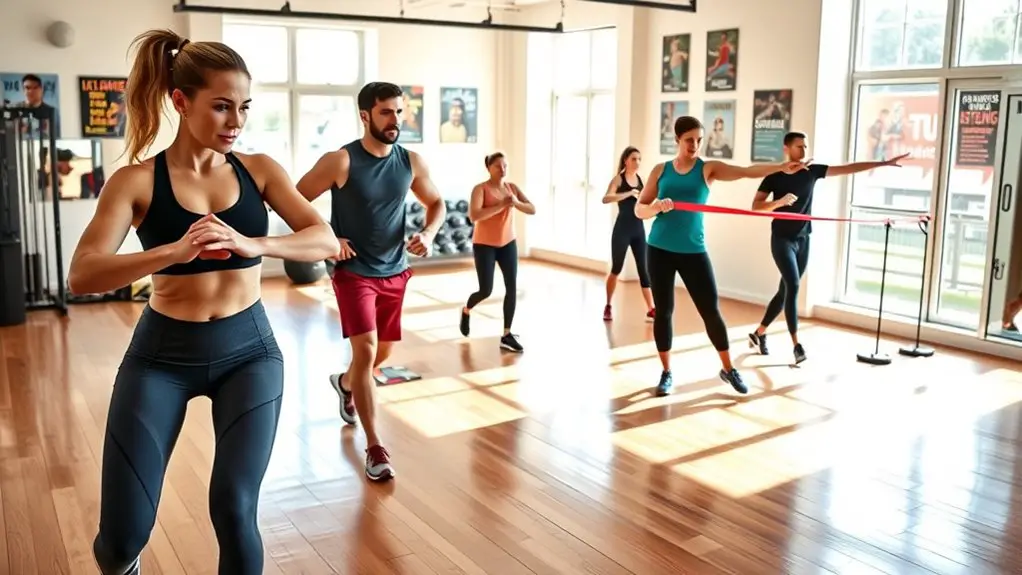
To prevent injuries in the gym, start with a proper warm-up routine. Dynamic stretching gets your muscles moving and increases blood flow, while activation exercises target specific muscle groups. A brief cardiovascular warm-up elevates your heart rate, getting your body ready for action. Don’t forget foam rolling to release tension, and use breathing techniques to enhance oxygen flow. Avoid common mistakes like skipping warm-ups, and you’ll set yourself up for success—keep exploring to discover more tips!
Understanding the Importance of a Warm-Up
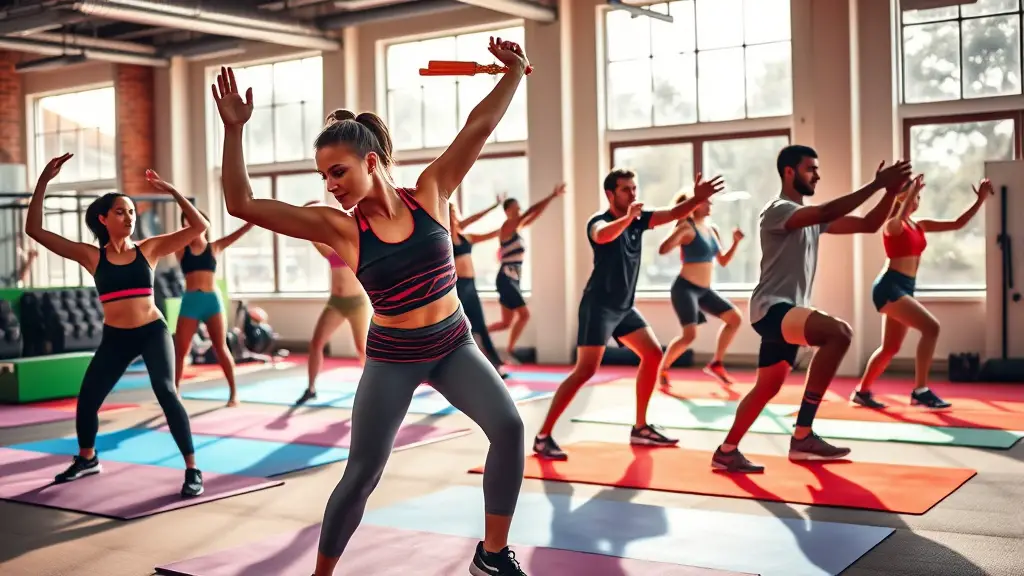
When you step into the gym, you might think that diving straight into your workout is the quickest way to achieve your goals, but skipping a warm-up can lead to injuries that set you back. Understanding the importance of warming up is essential for injury prevention. A proper warm-up increases your heart rate, enhances blood flow to your muscles, and prepares your body for the demands of your workout.
Dynamic Stretching: The Key to Mobility
Dynamic stretching is a powerful tool that can greatly enhance your mobility and prepare your muscles for action. Unlike static stretching, dynamic flexibility involves moving parts of your body through a full range of motion, effectively warming up your muscles. Incorporating mobility drills into your routine not only increases blood flow but also activates your nervous system, making your workouts more effective.
Start with movements like leg swings, arm circles, or walking lunges to target key muscle groups. These mobility drills help improve coordination and balance, reducing the risk of injury. You’ll find that as you consistently integrate dynamic stretching into your warm-up, you’ll experience greater ease in your workouts and daily activities. Additionally, focusing on proper technique during your warm-up routines can help prevent injuries, particularly in high-impact activities like jumping rope.
Activation Exercises for Targeted Muscle Groups
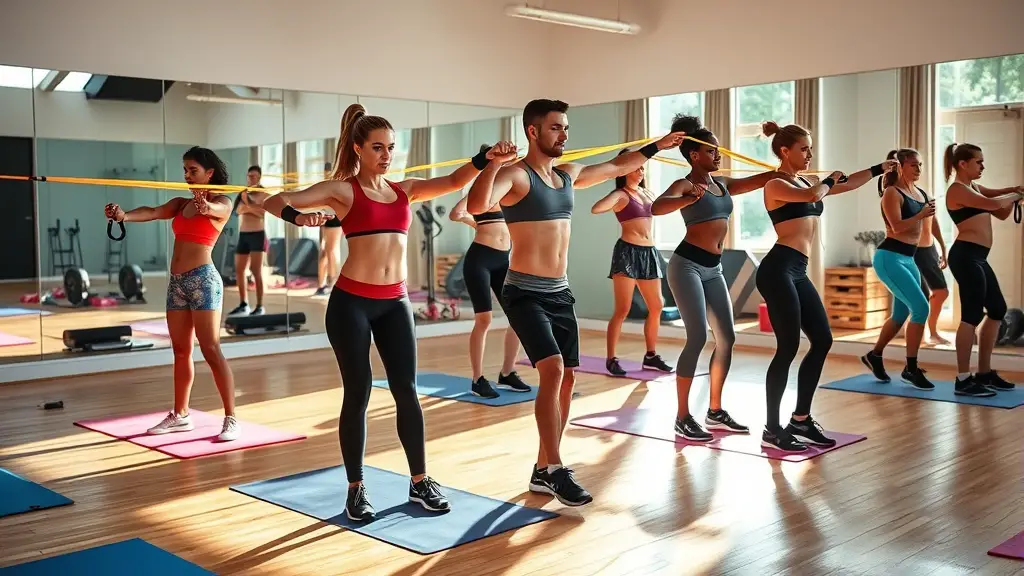
Incorporating activation exercises into your warm-up routine can greatly enhance your workout performance by specifically targeting the muscle groups you plan to engage. These muscle activation drills prepare your body, helping to prevent injuries and improve overall strength. Focus on movements that isolate the muscles you’ll use during your session.
Here’s a quick guide to effective activation exercises:
| Muscle Group | Targeted Exercises |
|---|---|
| Glutes | Glute bridges, clamshells |
| Shoulders | Band pull-aparts, external rotations |
| Core | Planks, bird-dogs |
Cardiovascular Warm-Up: Getting Your Heart Rate Up
To effectively prepare your body for a challenging workout, a solid cardiovascular warm-up is essential for elevating your heart rate and increasing blood flow to your muscles. Starting with 5 to 10 minutes of light cardio, like brisk walking, cycling, or jogging, can make all the difference. This initial activity helps raise your heart rate, making your heart more efficient and ready for higher intensity.
You’ll also reap significant cardiovascular benefits, as this warm-up enhances oxygen delivery to your muscles, improving performance and reducing injury risk. Remember, the key is to start slow and gradually increase your intensity.
Incorporating dynamic movements, like high knees or arm circles, can further activate your body. Not only does this prepare you physically, but it also mentally gears you up for the workout ahead. So, get that heart pumping and set yourself up for success!
Sport-Specific Warm-Ups for Enhanced Performance

While a general warm-up is essential, sport-specific warm-ups take your preparation to the next level by targeting the unique movements and demands of your chosen activity. Engaging in exercises that mimic your sport’s actions enhances performance and reduces injury risk.
For instance, if you’re a basketball player, include lateral shuffles and jump shots in your warm-up. Swimmers can benefit from shoulder mobility drills and dynamic stretches that simulate strokes. By focusing on sport specificity, you prepare your muscles and joints for the specific angles and motions they’ll encounter during competition.
Incorporating these tailored warm-ups not only primes your body but also boosts your confidence and mental readiness. You’ll find that you’re more agile, powerful, and focused, leading to performance enhancement. So, don’t skip this vital step—design a warm-up routine that aligns with your sport and watch your game improve!
Foam Rolling: Preparing Your Muscles for Action
Foam rolling is an essential part of your warm-up routine that can greatly enhance your performance and reduce the risk of injury. By using effective techniques and timing your rolling sessions properly, you’ll prepare your muscles for action and improve your flexibility. Let’s explore the benefits of foam rolling and how to make the most of this powerful tool.
Benefits of Foam Rolling
Rolling out your muscles with a foam roller can be a game changer when it comes to preventing injuries and enhancing performance. Foam rolling benefits include improved blood flow, reduced muscle soreness, and enhanced flexibility. By incorporating foam rolling into your routine, you’re not only preparing your muscles for action but also promoting faster muscle recovery.
| Benefit | Description | Impact on Performance |
|---|---|---|
| Improved Blood Flow | Increases circulation to muscles | Enhances nutrient delivery |
| Reduced Muscle Soreness | Minimizes post-workout discomfort | Allows for quicker recovery |
| Enhanced Flexibility | Improves range of motion | Boosts overall athletic ability |
| Injury Prevention | Releases tension and knots | Reduces risk of strains |
| Faster Recovery | Speeds up healing process | Prepares you for next workout |
Embrace foam rolling and elevate your workout game!
Techniques for Effective Rolling
To effectively prepare your muscles for action, mastering the right techniques for foam rolling is crucial. Start by identifying trigger points—those tight knots in your muscles. Gently roll over these areas, applying pressure for 20-30 seconds to promote myofascial release. Use slow, controlled movements to guarantee you’re targeting the right spots; rushing can lead to discomfort or injury. Focus on major muscle groups like your quads, hamstrings, and back, spending extra time on particularly tight areas. Don’t forget to breathe deeply, which helps your muscles relax. By incorporating these techniques, you’ll enhance flexibility, reduce soreness, and ultimately improve your performance. So grab that foam roller, and let’s get those muscles ready for action!
Timing Your Foam Roll
Finding the right time to incorporate foam rolling into your routine can make all the difference in your performance and recovery. For ideal rolling, aim to foam roll before your workout. This primes your muscles, enhances blood flow, and prepares your body for the demands ahead. Spend around 10-15 minutes focusing on tight areas to release tension and improve flexibility.
Post-workout foam rolling is equally important. It aids in muscle recovery by reducing soreness and promoting circulation. Try to foam roll for 5-10 minutes after your session, concentrating on any areas that feel particularly fatigued. By mastering foam roll timing, you’ll not only enhance your workout but also minimize the risk of injury, keeping you on track towards your fitness goals.
Breathing Techniques to Optimize Oxygen Flow
To maximize your performance and prevent injury, mastering breathing techniques is essential. By focusing on diaphragmatic breathing, you can enhance oxygen flow and support your movements effectively. Timing your breath with each exercise not only promotes relaxation but also guarantees that your body has the fuel it needs to push through the toughest workouts.
Diaphragmatic Breathing Benefits
While you may not think about it often, the way you breathe can greatly impact your workout performance and overall well-being. Diaphragmatic breathing focuses on using your diaphragm effectively, allowing for deeper, more efficient breaths. This technique not only enhances oxygen flow to your muscles but also promotes better endurance during workouts. You’ll notice that it helps with stress reduction, calming your mind and preparing you mentally for exercise. By integrating diaphragmatic breathing into your warm-up, you set the tone for a focused and energized session. As you practice, you’ll find it easier to maintain stamina and recover quickly, ultimately leading to improved performance and a more enjoyable gym experience. Embrace this powerful tool to elevate your fitness journey!
Timing Breath With Movement
As you move through your workout, timing your breath with each movement can greatly enhance your performance and oxygen efficiency. This practice, known as breath synchronization, helps your body utilize oxygen more effectively, allowing you to push harder and recover quicker. For instance, exhale during the exertion phase of a lift and inhale as you lower the weight. This not only stabilizes your core but also promotes movement efficiency, ensuring that your body performs at its best. By coordinating your breath with your movements, you can reduce fatigue and avoid injury. Remember, each inhale and exhale serves a purpose; mastering this technique can transform your workout and elevate your overall fitness journey. Focus on your breath—it’s your best ally in the gym!
Breathing Patterns for Relaxation
Breathing isn’t just about fueling your body during intense workouts; it also plays an essential role in relaxation and recovery. Mastering breath control can enhance your well-being and optimize oxygen flow. Here are some effective relaxation techniques to incorporate into your routine:
- Diaphragmatic Breathing: Inhale deeply through your nose, letting your diaphragm expand fully.
- Box Breathing: Breathe in for four counts, hold for four, exhale for four, and pause for four.
- 4-7-8 Technique: Inhale for four, hold for seven, and exhale slowly for eight counts.
- Mindful Breathing: Focus on the rhythm of your breath, letting go of distractions.
Common Mistakes to Avoid During Warm-Up
Many gym-goers underestimate the importance of a proper warm-up, which can lead to common mistakes that increase the risk of injury. One major mistake is skipping warm up altogether. It’s tempting to jump straight into your workout, but this can strain your muscles and joints, leaving you vulnerable to injuries.
Another pitfall is excessive stretching. While some flexibility work is beneficial, overdoing it can weaken your muscles before lifting. Instead, focus on dynamic movements that mimic your workout routine. Incorporate exercises like leg swings, arm circles, and torso twists to activate your muscles and improve your range of motion.
Lastly, don’t forget to include a gradual increase in intensity. Start slow to allow your body to adjust before pushing your limits. By avoiding these common mistakes, you’ll guarantee a safe and effective warm-up, paving the way for a successful workout.
Creating a Personalized Warm-Up Routine
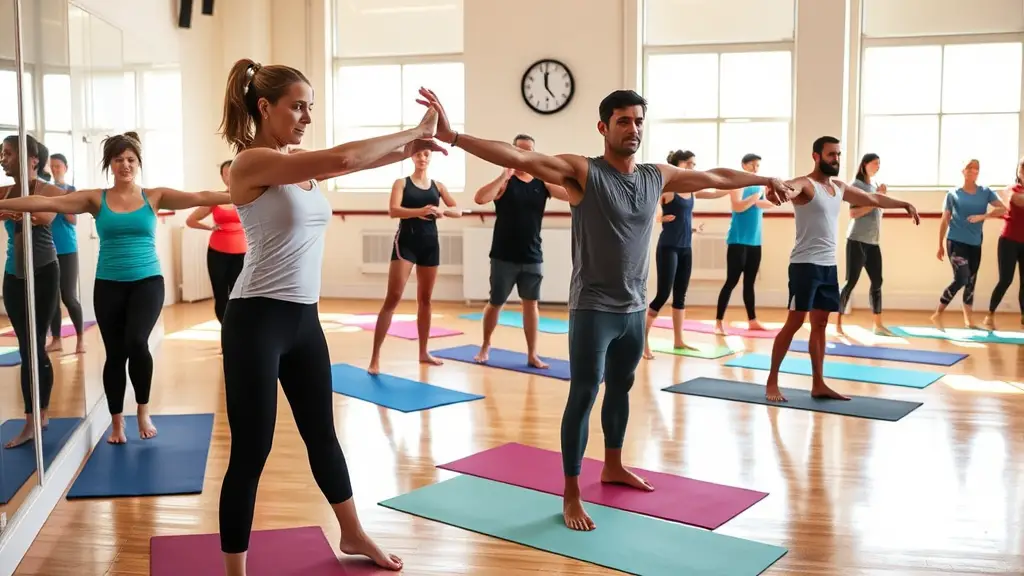
While crafting a personalized warm-up routine may seem intimidating, it’s an essential step toward enhancing your performance and preventing injuries. Tailoring your warm-up to your personal goals and fitness levels guarantees that you’re not just going through the motions. Here’s how to create an effective routine:
- Assess Your Fitness Level: Identify your current capabilities and limitations.
- Set Clear Goals: Define what you want to achieve, whether it’s building strength, improving endurance, or increasing flexibility.
- Incorporate Dynamic Movements: Include exercises like leg swings, arm circles, and torso twists to get your blood flowing.
- Gradually Increase Intensity: Start with low-intensity movements and progressively ramp it up to match your workout.
Frequently Asked Questions
How Long Should My Warm-Up Last for Optimal Results?
Think of your body like a car engine; if it’s cold, it won’t perform well. Your warm-up duration should ideally be around 10 to 15 minutes, focusing on moderate warm-up intensity. This way, you’ll gradually increase your heart rate and prepare your muscles for action. Skimping on time can lead to injury, just like a car struggling to start. So, invest those minutes wisely, and your workouts will thank you!
Can I Warm up Without Equipment?
Absolutely, you can warm up without equipment! Incorporate dynamic stretching and bodyweight exercises to get your blood flowing and muscles activated. Think arm circles, leg swings, or high knees; these movements boost flexibility and prepare your body for action. Aim for about 10 minutes, focusing on the major muscle groups you’ll use. Remember, a solid warm-up not only enhances performance but also reduces injury risk, so get moving and feel great!
What Are the Signs of an Effective Warm-Up?
An effective warm-up should get your heart rate up and increase blood flow to your muscles. You’ll notice improved mobility and flexibility as you incorporate dynamic stretching and mobility exercises. If you feel more agile and less stiff, you’re on the right track. Additionally, a good warm-up should mentally prepare you for your workout, making you feel energized and focused. Listen to your body; if you feel ready, you’ve likely warmed up effectively!
Should I Always Warm up Before Every Workout?
You should always warm up before every workout. It’s not just a myth; warming up enhances your performance by increasing blood flow and flexibility. Many believe it’s optional, but skipping it can lead to injuries. A proper warm-up primes your body for the intensity ahead, ensuring you’re ready to perform at your best. So, take those few minutes to prepare; your body will thank you, and you’ll likely see better results in your workouts!
How Does My Age Affect My Warm-Up Routine?
Your age can greatly affect your warm-up routine. As you get older, age considerations come into play; you might need longer and more dynamic warm-ups to increase blood flow and flexibility. It’s essential to incorporate warm-up modifications like gentle stretching and mobility exercises tailored to your body’s needs. Listen to what your body tells you, and remember, a proper warm-up can help prevent injuries and enhance your overall performance.


